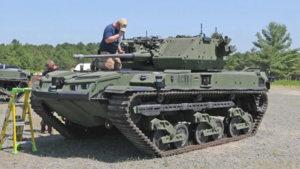| Ripsaw | |
|---|---|
 A Ripsaw M5 fitted with a Kongsberg RT40 turret in U.S. Army testing at Fort Dix, New Jersey in 2021. | |
| Type | Unmanned ground vehicle |
| Place of origin | United States |
| Production history | |
| Designer | Howe & Howe Technologies |
| Manufacturer | Textron Systems |
| Unit cost | US$295,000 (civilian variant) |
| Produced | 2009–present |
| Variants | MS1 (unmanned) MS2 (driver optional) |
| Specifications | |
| Mass | 9,000 lb (4,100 kg) |
| Height | 70 in (180 cm) |
| Crew | Up to 2 in manned variants |
| Armor | None (aluminum frame) |
| Engine | Duramax V8 engine 750 hp (760 PS; 560 kW) |
| Payload capacity | 2,000 lb (910 kg) |
| Suspension | 16 in (410 mm) travel |
| Ground clearance | 24 in (610 mm) |
| Maximum speed | 65 mph (105 km/h) |
The Ripsaw is a series of developmental unmanned ground combat vehicles designed by Howe & Howe Technologies (now part of Textron Systems) for evaluation by the United States Army.[1][2]
The Howe brothers started the Ripsaw as a small family project in 2000. They introduced it at a Dallas vehicle show in 2001, where it caught the interest of the U.S. Army. Later that year the U.S. military ordered a prototype MS-1 to be made and shipped to Iraq.[citation needed]
The Ripsaw is intended to perform various missions including convoy protection, perimeter defense, surveillance, rescue, border patrol, crowd control, and explosive ordnance disposal. For perimeter defense or crowd control, a belt of M5 crowd control munitions (MCCM) can be mounted around the vehicle to break up crowds or engage personnel with less-lethal flash-bang effects and rubber bullets. Cameras provide 360-degree coverage for situational awareness for the operator.[3][4]
The Army has tested the Ripsaw while remote-controlled by a soldier in another armored vehicle up to 1 km (0.62 mi) away. Its weapon system is modified to fire remotely using the Advanced Remote Armament System (ARAS), a gun that loads its own ammunition and can swap out various types of ammunition, such as lethal and less-lethal, in just a few seconds. These capabilities allow manned vehicles to send the Ripsaw out in front of them and engage targets without exposing soldiers to threats.[5] As of March 2017, the Army was still testing the vehicle as an unmanned platform to test remote controlled weapon stations.[6]
In October 2019, Textron and Howe & Howe unveiled their Ripsaw M5 vehicle,[7] and on 9 January 2020, the U.S. Army awarded them a contract for the Robotic Combat Vehicle-Medium (RCV-M) program. Four Ripsaw M5 prototypes are to be delivered and used in a company-level to determine the feasibility of integrating unmanned vehicles into ground combat operations in late 2021.[8][9][10] It can reach speeds of more than 40 mph (64 km/h), has a combat weight of 10.5 tons and a payload capacity of 8,000 lb (3,600 kg).[11] The RCV-M is armed with a Mk44 Bushmaster II and a pair of anti-tank guided missiles. The standard armor package can withstand 12.7×108mm rounds, with optional add-on armor increasing weight to up to 20 tons. If disabled, it will retain the ability to shoot, with its sensors and radio uplink prioritized to continue transmitting as its primary function.[12]
- ^ Teel, Roger A. (July 16, 2010). "Ripsaw demonstrates capabilities at APG". Army.mil. Archived from the original on August 6, 2010. Retrieved August 4, 2010.
- ^ "Textron Systems buys unmanned vehicle developer Howe & Howe". Reuters. January 10, 2019. Retrieved December 14, 2019.
the acquisition, which was finalised in December
- ^ "Weaponized RipSaw-MS2 UGV Evaluated for Convoy Security & Support". Defense Update. December 14, 2009. Archived from the original on January 5, 2010.
- ^ Goyal, Nidhi (September 25, 2013). "A 9,000-Pound Tank That's Faster Than a Ferrari". Industry Tap. Retrieved October 29, 2020.
- ^ Vergun, David (May 6, 2015). "Ripsaw could lead Soldiers into battle someday". Army.mil. Archived from the original on May 10, 2015.
- ^ McGarry, Brendan (March 21, 2017). "Army Still Testing Ripsaw, the 'Luxury Super Tank'". DefenseTech. Retrieved October 29, 2020.
- ^ Textron Rolls Out Ripsaw Robot For RCV-Light … And RCV-Medium. Breaking Defense. 14 October 2019.
- ^ US Army picks winners to build light and medium robotic combat vehicles. Defense News. 9 January 2020.
- ^ GVSC, NGCV CFT announces RCV Light and Medium award selections. Army.mil. 10 January 2020.
- ^ Army Picks 2 Firms to Build Light and Medium Robotic Combat Vehicles. Military.com. 14 January 2020.
- ^ Army Setting Stage for New Unmanned Platforms. National Defense Magazine. 10 April 2020.
- ^ Meet The Army’s Future Family Of Robot Tanks: RCV. Breaking Defense. 9 November 2020.